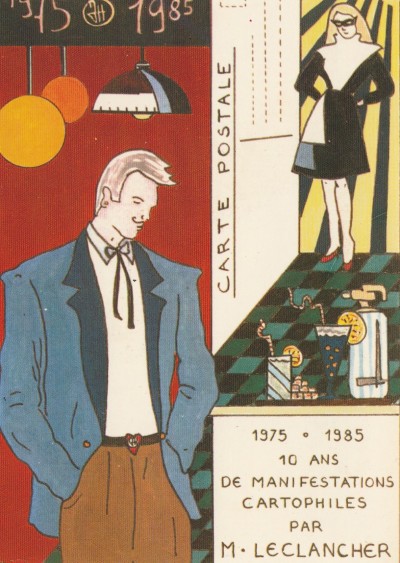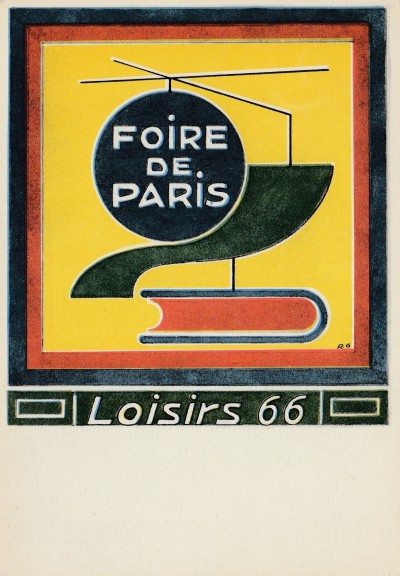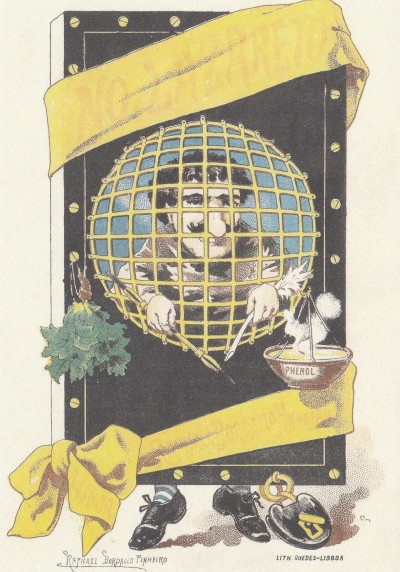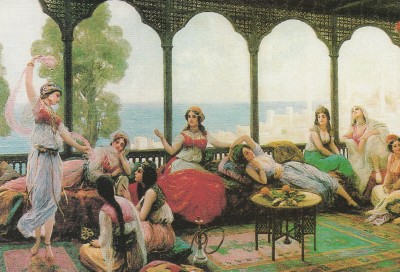June 9, 2016
By Andreea Grecu
The Ministry of Lost Decades
There are few new things in our human psyche and social behavior, but in recent years there has been a swift alienation due to the reduced direct contact with our fellow men. Vive l’Internet!

10 years of cartophiles events M. Leclancher, 1975-1985. Designed by Patrick Hamm (1985). Louis Barbier Editeur, Paris, 1985. Post card by Michel Leclancher : 10 ans de manifestations cartophiles. Sorce: private collection.
But one thing’s for sure: fear is an essential motive for which we keep our old ways. It was probably instinct that saved entire generations of humans by switching to fight or flight mode and depending on individual possibilities and concrete situations, fear has long been underrated. In fact, it is an important component for the way we make decisions and act in our daily lives. Culture, as part of our activities and lives, cannot get rid of these evidence.
How can we establish what kind of strategic cultural decisions (as few as they are, let’s not get ahead of ourselves) were taken as a follow up of some fear and how many were taken based on real analyses? There are always some palpable clues. Are we talking about status, salaries, the future of some job positions or an institution? The mixture of fear and a lucid decision is hard to detect at first site, the numbers can be deceiving. You just have to read three specific studies and two declarations from representatives of the international forums and you can wash your hands of the whole thing!

Foire de Paris, Loisirs 66. Post card, The philatelic committee of theFoire de Paris. Source: private collection.
Let us be alert and pay attention. Fear is an excellent trigger to pedal in an obviously outdated and morally used direction. Fear of what might happen to us, fear of what we might lose. Sure, it is very closely tied to the wish for control, for absolute supervision over a market or a sector. The task for the day is the oligopoly which soon becomes monopoly over the sources and resources of the cinema industry. It’s enough to be aware that now, in May 2016, two large economic groups hold approximately 80% of the financial market in Romania. And soon they’ll get their hands on 90-95%. Something they had to demonstrate.
Oh yeah, there’s also money, a big amount of money. But who can talk about them and about what happens to them? Again, fear is a overwhelming argument. I’d like to have a cultural policy that is less dictated by the fear of the future, that comes slowly but surely like steamroller, and focuses more on the artists and creators, on the public and education. This is a hard thing to accomplish when we are governed by total anxiety. The advantage of not being part of the whirlwind of anxiety that is treatable with institutional Xanax is that you can observe with detachment how we’re missing out because we’re too busy with the symbolic block of salt that may or may not crush the cultural sector.
1943 was a turning point for the entire continent. Hitler was ravishing Europe, London was being bombarded and turned to ruins, English children were evacuated to rural areas and women worked jobs that were once strictly destined for men.

“No Lazareto”, color lithography. Ass. « Raphael Bordallo Pinheiro », 1881, Museu Bordalo Pinheiro. When Rafael Bordallo Pinheiro came back from Brazil he was forced to stay in quarantine in the Lisbon lazarette, as a method of preventing the spread of yellow fever. During this time, he wrote and illustrated this book. Source: private collection.
During that time, Graham Green was publishing a master piece of so-called mystery novels in which the suspense of a timely death was gradually growing (The ministry of horror, 1943, Heinemann Publishing House, London). Perhaps terror, your last ride down the road which is harder to take than the effect of the actual disappearance, the certainty that we move forward, just like in the medical system, to a overall crash. Again, the cultural system cannot be an exception to the general note of the Romanian society’s tune to a complete mess. It’s like creating an oasis of peace and understanding in an ocean of storms, trash and shams. But couldn’t it be possible that this, an area that is subjective by default, be the place to set out a glimmer of light for setting an example for a new type of behavior? One that is anchored into reality and normality, as much as there is left in Europe and all over the place.

Belly Dance in Harem, Jean-Léon Gérome, post card, The Basilica Cistern Museum, Istanbul. Source: private collection.
The human and social failure of some calmer cultural systems would be a clue for us to not import their ways in a society that is already used for live experiments that were overturned by so-called reforms that did not took into account national legislation and wanted to demonstrate how modern we are without the adequate legislation, with no communication, with no information, translating laws and financial and salary systems, etc. that were used in a different legal frame, with other institutional relations and a different infrastructure. But as long as we live in fear of being a marginal European culture and we look for foolish guides that will lead us into the first ditch, we will only be translating norms and laws and we will experience the effects as in a vivisection.
POSTED BY
Andreea Grecu
Andreea Grecu is a cultural manager and lecturer. Between 1999-2004, then from 2009 onward, she is active on the NGO scene, as member of cultural associations and professional unions in domanis such a...



